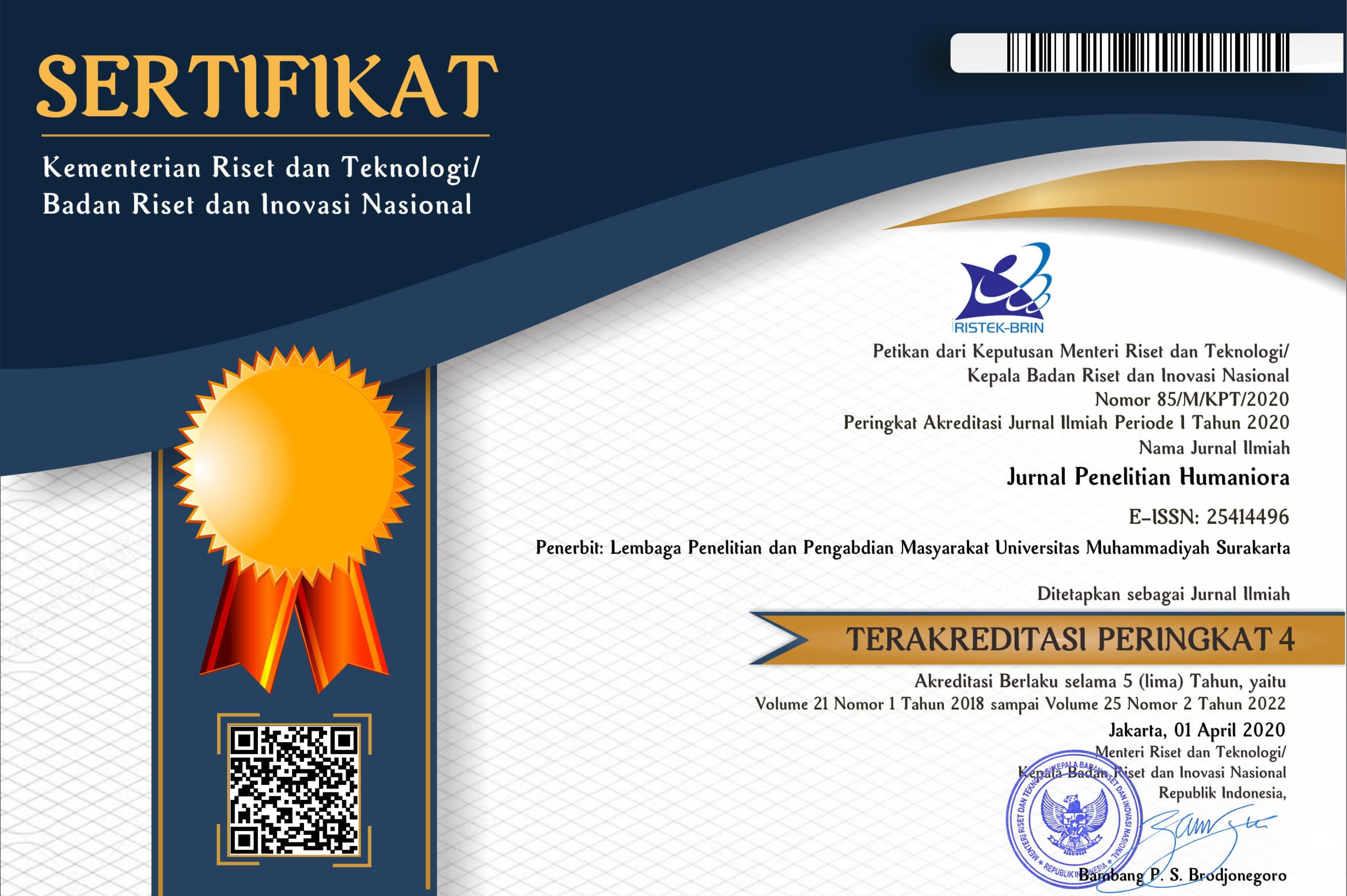MEN’S LANGUAGE FEATURES USED IN THE NETFLIX SERIES “SEX EDUCATION”: SOCIOLINGUISTICS STUDY
Winda Agustina(1*), Ervina CM Simatupang(2)(1) Widyatama University
(2) Widyatama University
(*) Corresponding Author
Abstract
This research aims to explore the language features employed by male characters in the Netflix series "Sex Education" and to uncover the underlying purposes associated with each linguistic feature utilized by these characters. Adopting a descriptive qualitative approach supported by quantitative data analysis, the study focuses on the verbal expressions of male characters within the series, encompassing words, phrases, clauses, and sentences within dialogues. Through meticulous analysis, the researcher identifies 249 instances of men's language features within the series. These instances were categorized into distinct types, with swear words or taboo language accounting for 30.5%, minimal responses or backchanneling comprising 27.7%, direct questions representing 20.7%, compliments based on skills at 11%, and explicit commands making up 10.1% of the total. The study delves into the various purposes associated with men's language features. These purposes encompass expressions of masculinity, establishment of dominance, facilitation of rapport, concealment of vulnerability, and negotiation of social hierarchies within diverse cultural contexts. In contrast, women's language features typically serve to express uncertainty, convey emotions, elicit responses, soften utterances, and emphasize points. The distinctiveness of men's language features lies in their inclination towards asserting dominance, taking specific actions, offering compliments, and gathering specific details, reflecting the multifaceted nature of gendered communication dynamics within the series.
Keywords
Full Text:
PDFReferences
Ahmed, U.A., & Sani, A. (2018). On Sociolinguistic Oriented Research on the Relationship between Language and Gender, and the Reality of Gender Condition in Africa. International Journal of Scientific and Research Publications (IJSRP).
Akhter, I. (2014). Differences in language use by male and female students in tertiary academia in Dhaka city.
Alfi, K. Z., Syamsi, K., & Efendi, A. (2023). Women’s Domination in Their Relationship with Language in the Movie “Tilik The Series.” Indonesian Journal of EFL and Linguistics.
Awasthy, R. (2019a). Nature of qualitative research. In Emerald Publishing Limited eBooks (pp. 145–161). https://doi.org/10.1108/978-1-78973-973-220191010
Chandra, D., & Yulia, M. (2017). NICKI MINAJ’S COMMENTS IN AMERICAN IDOL SEASON 12: AN ANALYSIS OF WOMEN’S LANGUAGE FEATURES. International Journal of Humanity Studies, 1(2), 185–193. https://doi.org/10.24071/ijhs.2018.010204
Coates, J. (2015). Women, men and language. Routledge eBooks. https://doi.org/10.4324/9781315645612
Fedele, M. (2021). La segunda generación de teen series: Programas estadounidenses, británicos y españoles de los 2000-2010. index.comunicación, 11(1), 297–327. https://doi.org/10.33732/ixc/11/01Lasegu
Ginanjar, B. R., & Simatupang, E. C. (n.d.). Swearing Words in “Euphoria” Television Show Sociolinguistic Study.
Glynn, D., & Sjölin, M. (Eds.). (2014). Subjectivity and epistemicity: Corpus, discourse, and literary approaches to stance. Centre for Languages and Literature, Lund University.
Hidayati, N. N. (2016). BAHASA DAN GENDER: KAJIAN KARAKTERISTIK KEBAHASAAN LAKI-LAKI DAN PEREMPUAN DALAM FILM ANAK. Al Hikmah: Jurnal Studi Keislaman, 6(1). https://doi.org/10.36835/hjsk.v6i1.2796
John Emike, A., Sanni, A., Nonyerem Agu, M., & Moses Olusanya, A. (2021). Introducing Sociolinguistics. Bulletin of Advanced English Studies, 6(2), 36–44. https://doi.org/10.31559/BAES2021.6.2.2
Juanda, K. U., & Simatupang, E. C. (2023). Women’s Language Features in Turning Red (2022): A Sociolinguistics Study. 13(1).
Juwita, T. P., Sunggingwati, D., & Valiantien, N. M. (2018). THE DIFFERENCES BETWEEN MEN AND WOMEN’S LANGUAGE IN THE DEVIL WEARS PRADA MOVIE. 2(1).
Kartika, F. N., & Rusnaningtias, E. (2017). Women Linguistic Features Used by Oprah Winfrey in Same-Sex Communication. 06(02).
Kiesling, S.F. (2015). Masculinities and language.
Lacalle, C., Gómez, B., Universitat de Lleida, Hidalgo, T., & Universidad de Alicante. (2021). History of teen series in Spain: Evolution and characteristics. Comunicación y Sociedad, 2021(0), 1–22. https://doi.org/10.32870/cys.v2021.7979
Larasati, V. O., & Simatupang, E. C. (n.d.). Language Styles in the Movie Luca (2021): Sociolinguistics Study.
McDonald, K. (2016). The sociolinguistics of gender, social status and masculinity in Aristophanes. Journal of Historical Sociolinguistics (Internet)/Journal of Historical Sociolinguistics, 2(2), 155–188. https://doi.org/10.1515/jhsl-2016-0011
Nguyen, D., Doğruöz, A. S., Rosé, C. P., & De Jong, F. (2016). Computational Sociolinguistics: A Survey. Computational Linguistics, 42(3), 537–593. https://doi.org/10.1162/COLI_a_00258
Nursanti, E. (2022). Men’s Language and Masculine Identity Construction in Sexist Jokes. Journal of English Language Teaching and Linguistics, 7(2), 255. https://doi.org/10.21462/jeltl.v7i2.818
Oktapiani, T., Natsir, M., & Setyowati, R. (2017). WOMEN’S LANGUAGE FEATURES FOUND IN FEMALE CHARACTER’S UTTERANCES IN THE DEVIL WEARS PRADA. 1.
Ouma, M. A., Chai, J. F., & Kitetu, C. W. (2022). BITING THE BULLET! A DISCURSIVE APPROACH ANALYSIS OF MASCULINITY IN THE REPRODUCTIVE HEALTH CLINIC. Zenodo (CERN European Organization for Nuclear Research). https://doi.org/10.5281/zenodo.6548023
Salihu, H. H. (2014). The Sociolinguistics Study of Gender Address Patterns in the Hausa Society. International Journal of Social Science and Humanity, 48–53. https://doi.org/10.7763/IJSSH.2014.V4.317
Sreetharan, S. (2017). Japanese Men's Linguistic Stereotypes and Realities.
Sulastri, S., &., D.M. (2019). Characterizing Men and Women Language In The Best Of Me Movie.
Usman, A. Hi., Mahmud, A. F., Daud, A., & Dahlan, S. (2020). LANGUAGE AS A SOCIAL INSTRUMENT. EDUKASI, 18(2), 259. https://doi.org/10.33387/j.edu.v18i2.2101
Yin, R. K. (2016). Qualitative research from start to finish (Second edition). The Guilford Press.
Article Metrics
Abstract view(s): 1422 time(s)PDF: 947 time(s)
Refbacks
- There are currently no refbacks.











